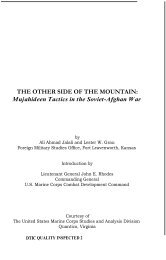hindustani fanatics, india's pashtuns, and deobandism â connections
hindustani fanatics, india's pashtuns, and deobandism â connections
hindustani fanatics, india's pashtuns, and deobandism â connections
- No tags were found...
You also want an ePaper? Increase the reach of your titles
YUMPU automatically turns print PDFs into web optimized ePapers that Google loves.
Hindustani Fanatics, India’s Pashtuns, <strong>and</strong> Deob<strong>and</strong>ism – Connectionsthe Yusufzai tribe, like the other Muslims living in this region. He was well aware of the military aspects of the area where he lived <strong>and</strong>, according toHafeez Malik, he played war games with his playmates <strong>and</strong> divided them into an “army of Islam” <strong>and</strong> an “army of infidels”, reflecting the seriousnessthe population viewed their recent defeat by Shujah-ud Daulah, the Sikhs, <strong>and</strong> the British army. If the contemporary sources are correct, even hismother took seriously her young son’s determination to fight the infidels, yet another indication that the surviving Rohillas accepted the Pashtunwalirequirement for revenge. Shujah-ud Daulah, a Shi’a, was a Muslim; but the Sikhs <strong>and</strong> the British were not <strong>and</strong> they appear to have been singled outas primary enemies for Sayed Ahmad Shah. It seems that young Ahmad Shah was indoctrinated from a very early age to become a combatant. Andhis mother was not to be disappointed.Associated with young Sayed Ahmad Shah’s ambitions to take war to the Sikhs <strong>and</strong> British enemies of Islam, infidels, was the relatively newpolitical-religious ideology created by Shah Waliullah as he observed the chaos of repeated succession crises within the Mughal Empire as it beganto fall apart. Waliullah probably associated the threat to Muslim rule in India with similar threat to Islam.Shah Waliullah was also from northern India 35 <strong>and</strong> would have been very familiar with the Rohillas who controlled much of the region wherehe was born. The district where he originated, Uttar Pradesh’s Muzaffarnagar district, had begun as an Afghan settlement 36 <strong>and</strong> he may have beena Rohilla, himself. The district remained under Rohilla control until 1780, eighteen years after Waliullah’s death in 1762, when it was plunderedby Sikhs. 37 His religious work seemed to focus on a revival of traditional Islam that he felt had been contaminated by beliefs absorbed from theircontacts with India’s Hindu population. He also probably viewed the gradual disintegration of the Mughal Empire as a parallel decline of Islam <strong>and</strong>worked against this trend as political instability began to spread. While he was a “traditionalist,” Waliullah was also revolutionary in some of hismethods. For example, he was the first to translate the Koran into Persian, something that must have been condemned widely as an “innovation” byother religious leaders as Waliullah opened many schools that carried his religious views to large numbers of young Muslim students.He also pointed out that while there was no provision for national churches for each country within the Islamic concept of the “Ummah,”Waliullah explained his belief that there were significant differences among the Muslim nations <strong>and</strong> each of them had generally developed separateschools of Islamic thought. Turkey had a significant Sufism influence, Iranian nationalism was centered on its Shi’a faith, <strong>and</strong> Arabia was closelyconnected to Wahabbism. Waliullah’s religious beliefs developed a school of Islamic thought that is relatively unique <strong>and</strong> is found primarily intoday’s Pakistan. 3835. From Wikipedia: Shah Waliullah was born in 1703 CE, in the town of Phulat in Muzaffarnagar, Uttar Pradesh, India. It is said his father, Shah Abdur Raheem, wasforetold of the birth of a pious <strong>and</strong> obedient son by Hazrath Qutubuddin Bakhteyaar-e-Kaaki, who made Shah Abdur Raheem promise that the boy will be named after him asQutubuddin Ahmad. So he named his boy Qutubuddin Ahmad. The name Shah Waliullah is given to him by people because Waliulla means “close to God” as he was very piousman. So his complete name was Shah Waliullah Qutubuddin Ahmad. His genealogy can be traced back to the second Caliph of Islam, Hazrath Umar Farooq (RA) from thepaternal side <strong>and</strong> to Hazrath Musa Kazim (RAH) on the maternal side. His gr<strong>and</strong>father, Sheikh Wajihuddin, was an important officer in the army of Shah Jahan who supportedPrince Aurangzeb in the war of succession. The forefathers of Shah Waliullah, Shaikh Shamsuddin Mufti came to the subcontinent <strong>and</strong> settled in Rothak during the initialperiod of Islamic rule. Although the mark of identification of this family was their comm<strong>and</strong> over religious sciences of Islam, one of his family members, Shaikh Mehmood,adopted the profession of a soldier after which tales of bravery remained associated with this family for a long time.36. Husain, pg. 16.37. Ibid, pg. 183.38. Malik, Hafeez, pp. 71-72. This section of Malik’s book has a good discussion related to religious nationalism.Tribal Analysis Center, 6610-M Mooretown Road, Box 159. Williamsburg, VA, 23188
















